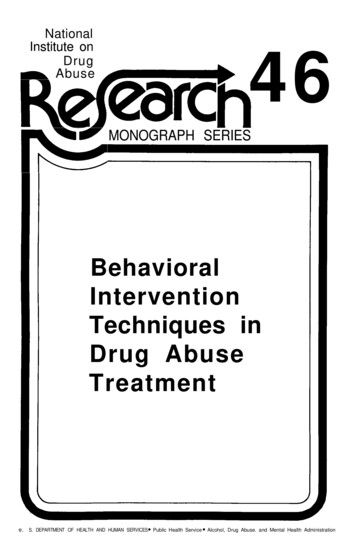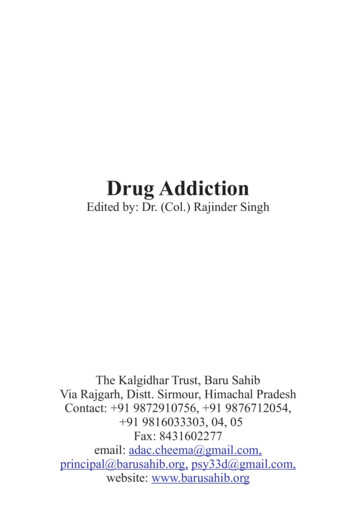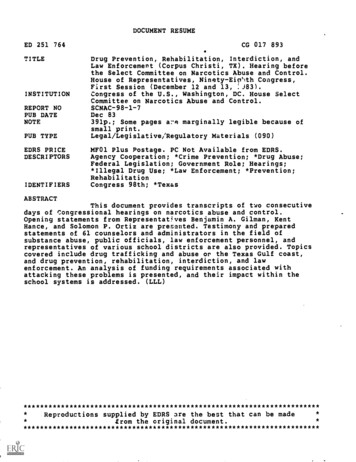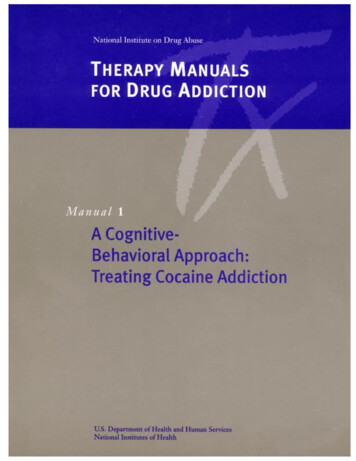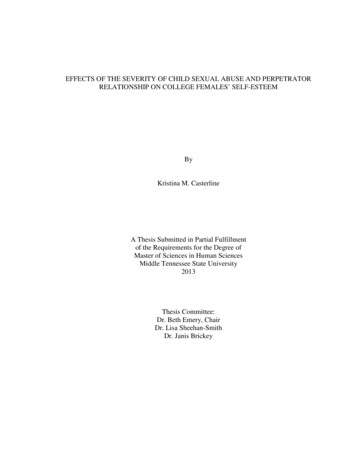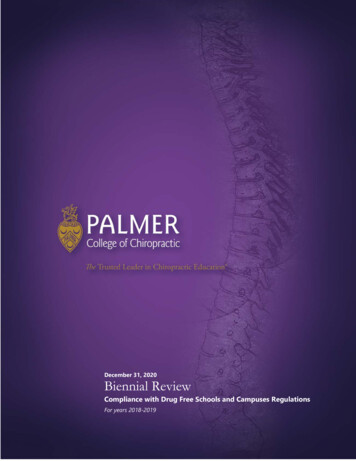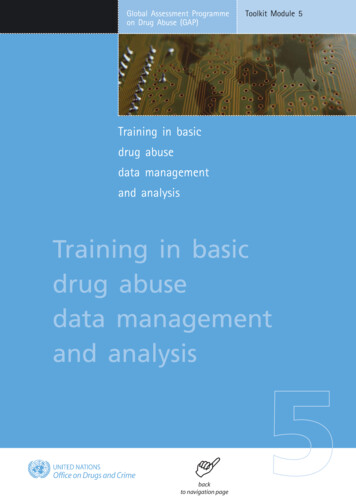
Transcription
Global Assessment Programmeon Drug Abuse (GAP)Toolkit Module 5Training in basicdrug abusedata managementand analysisTraining in basicdrug abusedata managementand analysis backto navigation page
UNITED NATIONS OFFICE ON DRUGS AND CRIMEViennaTraining in basic drugabuse data managementand analysisGlobal Assessment Programmeon Drug AbuseToolkit Module 5UNITED NATIONSNew York, 2005
UNITED NATIONS PUBLICATIONSales No. E.03.XI.18ISBN 92-1-148171-6The content of GAP Toolkit Module 5: Training in basic drug abuse data management andanalysis was produced by the United Nations Office on Drugs and Crime as part of theactivities conducted under the Global Assessment Programme on Drug Abuse (GAP).Other GAP activities include providing technical and financial support for the establishment of drug information systems and supporting and coordinating global data collectionactivities.For further information, visit the GAP web site at www.unodc.org, e-mail gap@unodc.org,or contact the Demand Reduction Section, UNODC, P.O. Box 500, 1400 Vienna, Austria.United Nations Office on Drugs and CrimePrinted in Austria, 2005
PrefaceThe Global Assessment Programme on Drug Abuse Toolkit Module 5: Training in basicdrug abuse data management and analysis has been produced by the United NationsOffice on Drugs and Crime as part of the activities conducted under the GlobalAssessment Programme on Drug Abuse (GAP). The main objective of GAP is toassist countries in collecting reliable and internationally comparable drug abuse data,in building capacity at the local level to collect data that can guide demand reduction activities and in improving cross-national, regional and global reporting on drugtrends. To support that process, GAP Toolkit Module 5 provides a hands-on introduction to the range of skills required for effective data management and analysisin the format of a training course. GAP Toolkit Module 5 consists of an introduction describing the context and rationale of the course and a set of 12 training sessions built around PowerPoint files with accompanying data sets, exercises andcommentary.The purpose of GAP Toolkit Module 5 is to provide a practical and accessible guideto implementing data collection in the core areas of drug epidemiology. Models andexamples presented in the modules are based on those that have been found to beeffective, but a key principle is that approaches will be adapted to meet local needsand conditions.Other GAP Epidemiological Toolkit modules include the provision of support for thedevelopment of an integrated drug information system, indirect methods for estimating prevalence, school surveys, data interpretation and management for policyformation, focused assessment studies using qualitative methods and ethical issues.iii
AcknowledgementsGAP Toolkit Module 5: Training in basic drug abuse data management and analysiswas prepared by André Noor with the support of the United Nations Office on Drugsand Crime (UNODC) as part of the activities conducted under the Global AssessmentProgramme on Drug Abuse (GAP).The Office would like to thank the participants of the Southern African DevelopmentCommunity Epidemiology Network on Drug Use (SENDU) and the East African DrugInformation System (EADIS) for their valuable assistance in piloting the trainingcourse in March and September 2002.v
ContentsPreface . . . . . . . . . . . . . . . . . . . . . . . . . . . . . . . . . . . . . . . . . . . . . . . . . . . . . . . . . . . . . .iiiAcknowledgements . . . . . . . . . . . . . . . . . . . . . . . . . . . . . . . . . . . . . . . . . . . . . . . . . . . .vINTRODUCTION . . . . . . . . . . . . . . . . . . . . . . . . . . . . . . . . . . . . . . . . . . . . . . . . . . . . . . .Background . . . . . . . . . . . . . . . . . . . . . . . . . . . . . . . . . . . . . . . . . . . . . . . . . . . . . .Scope . . . . . . . . . . . . . . . . . . . . . . . . . . . . . . . . . . . . . . . . . . . . . . . . . . . . . . . . . . .112I. ORGANIZING THE COURSE . . . . . . . . . . . . . . . . . . . . . . . . . . . . . . . . . . . . . . . . .Target audience . . . . . . . . . . . . . . . . . . . . . . . . . . . . . . . . . . . . . . . . . . . . . . . . . .Class size . . . . . . . . . . . . . . . . . . . . . . . . . . . . . . . . . . . . . . . . . . . . . . . . . . . . . . .Software and hardware . . . . . . . . . . . . . . . . . . . . . . . . . . . . . . . . . . . . . . . . . . .Format of the course . . . . . . . . . . . . . . . . . . . . . . . . . . . . . . . . . . . . . . . . . . . . .Practicalities . . . . . . . . . . . . . . . . . . . . . . . . . . . . . . . . . . . . . . . . . . . . . . . . . . . . .Content . . . . . . . . . . . . . . . . . . . . . . . . . . . . . . . . . . . . . . . . . . . . . . . . . . . . . . . . .Timetable . . . . . . . . . . . . . . . . . . . . . . . . . . . . . . . . . . . . . . . . . . . . . . . . . . . . . . .Role of the trainer . . . . . . . . . . . . . . . . . . . . . . . . . . . . . . . . . . . . . . . . . . . . . . .333345668II. INTRODUCTION AND NOTES ON TRAINING SESSIONS 2-13 . . . . . . . . . . . . .Session 1. Introduction and welcome . . . . . . . . . . . . . . . . . . . . . . . . . . . . . . .Notes on session 2. File management . . . . . . . . . . . . . . . . . . . . . . . . . . . . . . .Notes on session 3. SPSS data entry . . . . . . . . . . . . . . . . . . . . . . . . . . . . . . . .Notes on session 4. Types of question and types of variable . . . . . . . . . . .Notes on session 5. Coding closed questions . . . . . . . . . . . . . . . . . . . . . . . . .Notes on session 6. Coding open questions . . . . . . . . . . . . . . . . . . . . . . . . . .Notes on session 7. Recode and compute . . . . . . . . . . . . . . . . . . . . . . . . . . .Notes on session 8. Data analysis: frequencies . . . . . . . . . . . . . . . . . . . . . . .Notes on session 9. Data analysis: “Explore" . . . . . . . . . . . . . . . . . . . . . . . . .Notes on session 10. Table manners . . . . . . . . . . . . . . . . . . . . . . . . . . . . . . . .Notes on session 11. Data analysis: cross-tabulation . . . . . . . . . . . . . . . . . .Notes on session 12. Data cleaning . . . . . . . . . . . . . . . . . . . . . . . . . . . . . . . . .Notes on session 13. Documentation and “Help" . . . . . . . . . . . . . . . . . . . . . e:Model student questionnaire: Exercises 1, 2 and 3 . . . . . . . . . . . . . . .The pre- and post-test . . . . . . . . . . . . . . . . . . . . . . . . . . . . . . . . . . . . . . . .Questionnaires . . . . . . . . . . . . . . . . . . . . . . . . . . . . . . . . . . . . . . . . . . . . . . .Checklists . . . . . . . . . . . . . . . . . . . . . . . . . . . . . . . . . . . . . . . . . . . . . . . . . . .35515381The present publication should be used in conjunction with the accompanyingPowerPoint presentations, which contain trainer’s notes and slides for sessions 2-13of the training course.vii
IntroductionData management and data analysis is multidisciplinary, requiringsubject knowledge, computing expertise and a sound understandingof statistical principles. This course aims to provide instruction andhands-on practice in basic data management and data analysis toenable information on drug use to be summarized more effectively.BackgroundThe training course has been piloted twice: in March 2002 with members of the Southern African Development Community EpidemiologyNetwork on Drug Use (SENDU) and in September 2002 with twogroups from the East African Drug Information System (EADIS) (oneEnglish-speaking and the other French-speaking, each with approximately 10 participants). In both instances, the training took place inPretoria under the aegis of the Global Assessment Programme on DrugAbuse (GAP). The pilot courses provided valuable information on theneeds of the participants and the practicalities of presenting a courseon data management and analysis.Data, both quantitative and qualitative, are central to the work of theIntegrated Drug Information Systems (IDIS) and the focal groups thatcoordinate this work. More information on IDIS is presented in GAPToolkit Module 1: Developing an Integrated Drug Information System,available at www.undcp.org/drug demand gap m-toolkit.html.In outline, IDIS consists of parties from a broad range of disciplinesand agencies. These may include drug treatment centres, law enforcement agencies and health services in their various forms. The task ofIDIS is to gather and summarize the available information on druguse in a coherent and standard manner. The overriding goal is tomonitor accurately the scale and nature of and trends in drug use ina country or region and thus improve the effectiveness of drug demandreduction responses.The need for support in basic data analysis has been identified aspart of the Information, Needs and Resources Analysis (INRA) completed by GAP in Africa, the Caribbean and Central Asia. The present GAP Toolkit Module 5 is intended to meet, at least in part, thisidentified need.1
GAP Toolkit Module 3Training in basic drug abuse data management and analysisScopeToolkit Module 5 provides an introduction to basic data management and data analysis. It brings together the necessary computing and statistical skills to organize dataand generate standard descriptive statistics. Basic statistical principles are discussedin context, that is, where they clarify the data management and analysis process.The course does not cover the principles of inferential statistics nor the methods ofsurvey sampling.There are a number of reasons for limiting the scope of the course to data management and descriptive statistics. First, careful data management is important fordata validity. Errors can be identified through careful data management. Equally,errors can creep into the data through haphazard data management.Second, the topics covered match the immediate needs and abilities of the participants. The GAP Toolkit modules provide a starting point for developing good practices in data collection, management and analysis and are intended to be appropriateto the existing level of expertise of the participants in IDIS. The course attempts tomeet these principles. It is envisaged that participants will use the skills presentedin the course to manage and present data to their network meetings, to enhancethe comparability of data and to organize the raw information needed to completethe drug abuse data component, that is, part II of the Annual Reports Questionnaireof the United Nations Commission on Narcotic Drugs.Finally, the nature of much of the data collected by IDIS makes the application ofinferential techniques problematic. Drug use is by nature clandestine. Standard survey techniques require careful consideration and adjustment to meet the requirements of the subject matter. The selection of interviewees is frequently not randomand only representative of a limited population. Where surveys are designed to berepresentative of a larger population, it is generally necessary to consider the individual circumstances and turn to experts with a broader background in statistics.2
Organizing the courseChapter ITarget audienceThe target audience for the module is those who wish to present acourse on data management and analysis to members of the druginformation networks. It is hoped that those taking the course maygo on to train others within their drug information network.Class sizeThe pilot courses were run with approximately 10 participants in each,which is a manageable number for a single trainer. The greater thenumber of participants, the longer it will take to complete the exercises and the greater will be the demands on the trainer. Class sizesgreater than 14 would make it difficult for the trainer to devote sufficient time to resolving individual problems, in particular as participants are likely to have different levels of experience of computersand statistics.Software and hardwareModern data management and analysis relies on the use of computer packages. The software required on each machine is StatisticalPackage for the Social Sciences (SPSS), Adobe Acrobat (for the SPSS“Help” files), Word, PowerPoint and Excel. It is assumed that themachines are running a Microsoft Windows operating system. Whenloading SPSS, trainers should complete a custom installation andinstall the SPSS “Syntax Guide”. The “Syntax Guide” will be usedfrom session 7 onwards.The version of SPSS used in the course is version 11. However, thecourse is directly applicable to all versions of SPSS from version 10onwards.3
GAP Toolkit Module 5Training in basic drug abuse data management and analysisThe individual presentations or sessions state which software packages should beopen for that presentation or session. PowerPoint and SPSS should be opened as aminimum. Windows Explorer is used extensively in session 2 on file management.Excel and Word are used to demonstrate copying SPSS output to other packagesand used extensively in session 10 on table manners.* Adobe Acrobat is necessaryto display the SPSS “Syntax Guide” and should open automatically whenever the“Syntax Guide” is invoked.The participants will need at least two diskettes to save their work during the course.At the end of the course, ideally, the participants should receive a compact disk(CD) containing all of the PowerPoint presentations, data files, exercises and theirown files from the course. A computer with a CD-writer and a stock of blank CDswould be needed.One final point on hardware: within many developing countries, the electrical supply is not reliable, necessitating the use of uninterrupted power supply batteries toprovide enough time to turn the computers off if the power supply fails. Trainersshould also check whether transformers are needed to match local electricity plugs.A checklist of the hardware and software required by trainers and suggestions as tothe documentation that participants should bring to the course are given in annexIV, at the end of the present publication.The trainer should review the hardware and software available to the students, drawtheir attention at the beginning of the course to any differences that might be foundduring the course of the presentation and try to compensate for them during thepresentations. This should prevent participants becoming confused if their computer and the presentation do not match perfectly.Format of the courseA typical session would involve the trainer presenting a topic using a PowerPointpresentation and demonstrating various SPSS techniques. Participants are expectedto complete various exercises during or at the end of the session.The exercises provide an opportunity for the participants to obtain hands-on experience of using the software. During the exercises, the trainer should move aroundthe class helping individuals to get started and answering specific questions.* It is assumed that Microsoft products are being used as they are the most common and can be usedas intermediaries between SPSS and more obscure software packages. SPSS will output to other file formats, although it should also be possible to output to Excel and Word files, which will in turn be readby most other spreadsheet or word-processing packages.4
Chapter IOrganizing the courseIn addition to the exercises within the sessions, there are three larger exercises thatbring together a range of topics. The exercise sheets for the three larger exercisesand accompanying trainer’s notes are given in annex I. A 90-minute session shouldbe devoted to each of these exercises.PracticalitiesThe format of the course raises a number of practical considerations.First, in order for the students to follow a PowerPoint presentation and SPSS demonstrations, there must be some method of displaying the trainer’s computer screento the audience. The simplest method is a data projector, which was used effectivelyduring the pilot sessions, although there are more sophisticated systems for thistask. The trainer should acquaint himself or herself with the presentation hardware,ensuring, in particular, that necessary back-ups, such as replacement bulbs, are available.Second, the trainer will be required to switch between software packages during apresentation, primarily between PowerPoint and SPSS, although in some instances,Adobe Acrobat, Windows Explorer, Word and Excel will also be used. The simplestmethod of switching between software packages running on a computer is to startby opening all the packages that will be required. Once all the necessary softwarepackages are open, holding down the Alt key on the keyboard and pressing the Tabkey will move control between them.Third, to complete the exercises, the participants must have access to a computerloaded with the relevant software. There is no strict rule for the number of studentsper computer. One student to a computer ensures that each student completes theexercises. However, working in pairs allows the participants to share their knowledge and tends to speed up the exercises. The danger of sharing is that one of thepair becomes passive, allowing the more competent or more forthright of the pairto do most of the work. If participants are working in pairs, the trainer should ensurethat the hands on the keyboard change by establishing a rotation system, eitherbetween sessions or halfway through the exercise. Three or more to a computer isnot advisable, as either the training will take far longer or the participants will notreceive the necessary hands-on practice. The particular conditions where the training is held will of course be the determining factor, although where there are morethan two to a computer, additional practical sessions may be desirable in order tostagger the use and ensure every participant obtains hands-on experience.The experience of the pilot sessions was that participants tended to start the courseworking individually, but, as the exercises became longer and more detailed, a substantial proportion worked together in pairs, some then duplicating the results onthe second computer. This could be a result of the country focal points sending two5
GAP Toolkit Module 5Training in basic drug abuse data management and analysisparticipants to the training sessions, but it is a positive outcome as it reflects thesharing of expertise that is integral to the work of the drug information networks.ContentThe course can be broken into three broad, interconnected areas: basic computing,data management and data analysis.Basic computing skills cannot be assumed for participants from developing countries. In the pilot sessions there were participants who had never used a computerbefore. Session 2 on file management covers the fundamental computing skills thatare required to complete the course.Data management is the primary topic in the following nSession3.4.5.6.7.12.13.SPSS data entryTypes of question and types of variableCoding closed questionsCoding open questionsRecode and computeData cleaningDocumentation and “Help"Data analysis is the primary topic in the following a analysis: frequenciesData analysis: “Explore”Table mannersData analysis: cross-tabulationThe topics are interrelated, so each of the sessions contains, in varying amounts,instruction in statistical principles, in the use of SPSS and in general computer use.TimetableThe course is intended to be adapted by trainers to their own needs. The individual timetable will be determined by the adaptation. Some comments on adaptingthe course appear next, followed by a proposal for a timetable for the full courseand observations on the experiences in the pilot workshops.The course is designed to be run over five days, with approximately six hours ofcontact time a day. However, the speed at which the topics can be covered will6
Chapter IOrganizing the coursedepend largely on the level of expertise of the participants. It is conceivable that,with experienced computer users and some tailoring of the topics, the workshopcould be completed in four days. When adapting the course for a particular workshop, the trainer should consider carefully the amount of time that will be requiredto deliver the topics. For novices, five days will be needed.The circumstances of the individual workshop will determine how best to break upthe day. It is not advisable to have time slots that are too long, as both participantsand trainers become weary and bored. Time slots of 90 minutes are reasonable, bearing in mind that there will be some differentiation within the session between presentation and hands-on exercises.Some flexibility is needed in matching presentations to the 90-minute time slots. Thereare 13 sessions in the course and three long exercises, giving a total of 16 definedunits to fit in a total of 20 time slots. The sessions and exercises are not uniform intime. In particular, sessions 1, 2 and 10 are likely to take longer than the designated90 minutes. The time needed for the exercises is largely dependent on the participants’previous experience, although exercise 1 is likely to take longer than 90 minutes.For a five-day course, the following timetable of topics would be appropriate:Day 1 IntroductionFile managementSPSS data entryDay 2 Types of question and types of variableCoding closed questionsExercise 1Coding open questionsDay 3 Exercise 2Recode and computeExercise 3Using a syntax file and recoding variablesDay 4 Data analysis: frequenciesData analysis: “Explore"Table mannersDay 5 Data analysis: cross-tabulationData cleaningDocumentation and “Help”It is likely that some drifting of topics between days will occur, but it is still worthwhile presenting the participants with a timetable, if only to map the progressionof the course.7
GAP Toolkit Module 5Training in basic drug abuse data management and analysisRole of the trainerThe trainer will adapt the teaching materials to the demands of the specific coursethey are presenting, bearing in mind the time available for the course and the levelof expertise of the participants. The trainer is responsible for ensuring that the necessary hardware, software and documentation to complete the course are available.The trainer will present the PowerPoint presentations to the class, elaborate on theinformation provided in the slides and the slide notes, answer specific questionsfrom the participants and demonstrate the computing techniques, where appropriate. In addition, the trainer is expected to comment on the questionnaires and databrought by participants, if requested.The demands on the trainer are substantial. Teaching computing, statistics and dataanalysis techniques requires detailed knowledge on the part of the trainer and a willingness to help the participants at a level beyond that of a standard university course.The participants are likely to be a heterogeneous group, necessitating a high levelof individual attention. The size of the group must be small enough to ensure thisis a feasible proposition.8
Introduction and notes ontraining sessions 2-13Chapter IIThe notes on sessions 2-13 below are to be used in conjunction withtraining sessions 2-13 contained in the accompanying PowerPoint presentations.Teaching is as much an art as a science and much of what followswill reflect the personal approach of the author. Trainers adopting thecourse will bring their own approach to the materials and will enhanceand reject various components. The following discussion describes thecourse in greater detail and should help trainers to arrive at their personal decisions as to how to use the materials.A set structure has been adopted for the following discussion, centredon the aims, objectives and learning outcomes of each session. The aimsand objectives define the educational goals that are to be achieved [1].Aims represent broad, expansive goals, while objectives are narrowerspecific topics that are to be covered. Learning skills are specific skillsthat the student is expected to have attained at the end of the session.Having defined the aims, objectives and learning outcomes of the session, the pilot workshops will be used as case studies to highlight anyparticular costs or benefits.The course consists of 13 sessions, each described below. The content of the sessions can be broken into three distinct but interlinkedtopics: computer expertise, data management and data analysis. Eachtopic is made up of both practical hands-on instruction and discussions of the underlying principles.Computer expertise is developed throughout the course. The maincomputing principles and skills needed to complete the course arerelated to file management and are presented in session 2. These arereinforced by repeated use throughout the course. The amount ofemphasis given to this part of the course will depend largely on thelevel of expertise the participants bring to the course. An inability tocomprehend how and where to save files will disrupt the course andlead to confusion. It is not advisable to omit this component unlessabsolutely certain that the participants can complete all the basic file9
GAP Toolkit Module 5Training in basic drug abuse data management and analysismanagement tasks. Trainers should be aware that participants are frequently unwilling to admit gaps in their knowledge so an objective measure of their abilities shouldbe used rather than a reported measure.The instruction in data management covers how to code open, closed and compoundquestions. The principles underlying the data management topics are discussed, thenput into practice using SPSS and a range of both real and constructed data. Datamanagement is the topic of sessions 3 to 7. Data management is revisited in the lasttwo sessions, 12 and 13. Session 12 describes and demonstrates data cleaning. Session13 discusses documentation. Data cleaning and documentation appear at the end ofthe course as they require a fluency in SPSS and an understanding of the codingprocess that is built up in the earlier stages of the course. A positive externality isthat these two topics provide reinforcement of the practical SPSS skills presented inthe course and can be used by the trainer to gauge the participants’ progress.Data analysis is the topic of sessions 8 to 11. The focus is on description ratherthan inference. Instruction is provided in describing single categorical and continuous variables. Two types of bivariate analysis are mentioned. First, an informal comparison of statistics on a continuous variable for each of the categories of a nominalvariable. Second, cross-tabulation of categorical variables. For each of the topics, abrief discussion of statistical principles is followed by hands-on practice.The course has been tailored to the needs of the members of the drug informationfocal groups. Where possible, examples relevant to the collection of drug use information and the Annual Reports Questionnaire have been adopted. The level of thetraining has been set to match the likely prior knowledge of the participants on thebasis of information provided by GAP regional epidemiological advisers and the experience of two pilot workshops in South Africa.The course should be seen as the start rather than the end of the participants’ training in data management and analysis. Those attending the course are encouragedto use the available “Help” facilities in SPSS to further develop their knowledgeindependently. The course provides participants with the necessary skills to undertake simple data management and analysis of drug use data and prepares the participants for independent study and/or further instruction in inferential statisticsand more sophisticated statistical techniques.Session 1.Introduction and welcomeThe aim of session 1 is to present a preview of the course and put the participantsat ease.The objectives of session 1 are as follows:1. To introduce the trainer.2. To introduce the participants.10
Chapter IIIntroduction and notes on training sessions 2-133. To describe the nature and structure of the course.4. To highlight the consequences of the heterogeneous nature of the participants.5. To agree a set of rules for questions and participation in the course.6. To deliver a short test.Learning outcomes are not applicable for this session.The first session differs greatly from the other sessions in that it is not centredaround a PowerPoint presentation or an exercise. Nevertheless, it is of great importance in ensuring the effective completion of the course. The participants are likelyto approach the first session with a certain amount of trepidation. Establishing acommon ground with the participants and a non-threatening environment is essential. It is generally the unknown that is discomforting, so the first session is designedto allay many of the participants’ anxieties.IntroductionsIntroductions answer the question of who is attending the course. They also provide an opportunity to gauge the abilities of the class.The pattern adopted in the pilot courses was for the trainer to introduce himself orherself first. The trainer’s introduction included a reminder that the need for training in basic data management and analysis was identified by the focal groups andthat the course was intended to meet this identified need. A basic outline of the computing and statistical background of the trainer was given as a personal introduction,effectively answering the question “Why should this person be offering the training?”.Participants were asked to briefly introduce themselves and answer the followingthree questions:1. What was their role in the data collection/analysis/reporting process?2. Did they have a computer on their desk at work and, if so, was it sharedwith anyone else?3. Did they use SPSS or MS Excel or any similar spreadsheet in their work?The first question identifies the
The content of GAP Toolkit Module 5: Training in basic drug abuse data management and analysis was produced by the United Nations Office on Drugs and Crime as part of the activities conducted under the Global Assessment Programme on Drug Abuse (GAP). Other GAP activities include providing technical and financial support for the establish-


